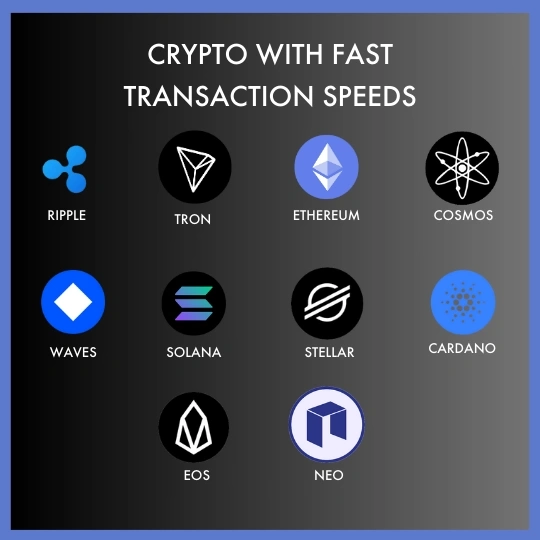A common misconception is that NFTs are just digital art—images stored on the blockchain. NFTs, also known as non-fungible tokens, are far more versatile and complex. They represent unique digital assets that can range from art and music to virtual real estate and beyond.
As technology advances, NFTs are evolving, becoming more interactive and integrated into our daily online experiences. In this guide, we’ll explore how AI, social media, and decentralized tech are increasing accessibility for all types of users. NFTs are no longer just for the tech savvy, but now for anyone interested, such as creators, collectors, businesses, and consumers.
One of the major concerns surrounding cryptocurrency and its ability to become the new financial system of the world has been transaction speeds. Currently, Visa has the power to process 24,000 transactions per second—hence why it’s one of the most widely used and accepted payment processing platforms.
Although, in the early days, cryptocurrency transaction speed was a concern and rapid and noticeable developments are being made to enhance some blockchain networks, moving us closer to near-instant transactions.
As a society, both individuals and businesses are accustomed to instant payment processing. To attract a mass audience and make crypto viable for everyone, it must overcome the challenges and present transaction speeds equivalent to what we’re used to.
How Are Transaction Speeds Measured, and What Is TPS?
TPS, or Transactions Per Second, indicates the number of transactions a blockchain network can manage in one second. Essentially, it is a gauge of a network's speed and throughput, illustrating its capacity to deal with numerous transactions at once. The TPS value significantly influences the scalability of a cryptocurrency and the overall user experience.

The Top 10 Fastest Crypto Transaction Speeds
Although Bitcoin is the most well-known cryptocurrency, its transaction speeds are relatively slow in comparison to other cryptos. Some are rapid and able to process large volumes of transactions quickly.
Let’s take a look at the crypto with the fastest transaction speed in 2024.
Ripple (XRP)
Ripple, known for its swift transaction speed, can process up to 1500 transactions per second, with settlement times of just 3-5 seconds. XRP offers a significant improvement over its counterparts like Bitcoin and Ethereum, which may require minutes or even hours to finalize transactions, enabling it to offer the fastest blockchain transactions per second. Get started with XRP.
Ethereum (ETH)
Ethereum recently completed its merge and switch to Ethereum 2.0 Today, with the network completing up to 100,000 transactions per second. While its validation speeds are still around 13 seconds, the drastic increase in TPS makes it a more scalable and realistic option for a global payment system. Get started with ETH.
Solana (SOL)
Solana, which started in 2020, addresses the scalability issues that other blockchain networks often face. Capable of handling up to 24,000 transactions per second, Solana is a heavyweight contender when considering the fastest crypto transaction speed. Get started with SOL.
Cosmos (ATOM)
Cosmos stands out with its high-speed transaction capability, offering up to 10,000 transactions per second (TPS) via its Tendermint consensus algorithm. However, the actual transaction speed can vary based on network congestion and the application in use. Get started with ATOM.
EOS
Launched in 2018, EOS is a blockchain platform purpose-built for speed and efficiency, particularly for decentralized applications (dApps). EOS's top-notch transaction speed peaks at around 4,000 transactions per second (TPS), making it one of the most scalable blockchain platforms. Get started with EOS
Cardano (ADA)
Renowned for its transaction speed, Cardano is capable of processing more than 1,000 transactions per second (TPS). With a speed comparable to EOS, it significantly outpaces the transaction speed of Bitcoin. Get started with ADA.
Stellar (XLM)
Stellar’s core software allows the network to handle up to 1,000 transactions per second. Designed to connect businesses to the blockchain, XML offers a confirmation time of 3-5 seconds.
Overall, it offers cost-effective transactions to businesses, enabling them to implement cryptocurrency into their day-to-day operations. Get started with XLM.
Tron (TRX)
Tron's impressive transaction speed of roughly 2,000 transactions per second (TPS) is achieved through various optimizations. It uses a delegated proof-of-stake, a high bandwidth network, and a block time of just 3 seconds. Get started with TRX.
Waves
Waves, a blockchain platform tailored for custom digital assets and decentralized applications (dApps), offers a transaction speed of about 100 transactions per second, amounting to 6,000 transactions per minute. Get started with WAVES.
NEO
Initially known as Antshares before rebranding to NEO in 2017, this blockchain platform has made a name for itself through high transaction speeds. As per the referenced Bitdegree article, NEO manages around 15 transactions per second (TPS). Get started with NEO.
Bitcoin
The Bitcoin transaction speed now is relatively slow, at just 7 TPS, meaning it is unlikely to become the blockchain of choice for creating a rapid and user-friendly payment system. However, teams are working on developing layer 2 blockchains that will increase P2P transaction speed. The Lightning Network opens a channel between two wallets that can complete transactions near-instantly. Get started with BTC.
Only when the channel is closed will these transactions be added to the layer 1 blockchain.
Why Does Cryptocurrency Transaction Speed Matter?
The aim is to create the most efficient blockchain network, and efficiency is judged by the number of transactions that can be successfully processed in a specified time—usually per second or minute.
Something to remember is the multiple variables that can dictate crypto transactions per second. As blockchain is a peer-to-peer system, it isn’t as straightforward as a centralized network such as Visa.
Block size, block time, transaction size, and network traffic are all major factors to consider.
Nodes working in the network have to complete the verification and processing of one transaction before they can move on to the next. When network activity is high, this slows the cryptocurrency transaction speeds.
Fastest Crypto Transaction Speed: Proof of Stake vs. Proof of Work
To further familiarize yourself with transaction speeds, it’s important to understand that cryptocurrency networks use consensus protocols like proof-of-work (PoW) and proof-of-stake (PoS) to process transactions.
PoW, used by Bitcoin, involves miners solving complex puzzles to validate transactions, a process called mining. This requires substantial computational power and energy, often leading to slower transaction speeds due to increasing puzzle complexity and competition among miners.
On the other hand, PoS networks select validators based on the number of coins they hold and stake. This method is more efficient, significantly speeding up transaction validation and consuming less energy compared to PoW. As such, PoS-based cryptocurrencies often offer faster transaction speeds and scalability, making them a more environmentally friendly option.
The Balancing Act: Scalability vs. Decentralization in Cryptocurrencies
Cryptocurrency developers often face a significant trade-off between scalability and decentralization.
Scalability refers to a network’s ability to handle a growing amount of work or its potential to be enlarged to accommodate that growth. In the context of cryptocurrencies, it's about the ability to process an increasing number of transactions swiftly.
On the other hand, decentralization is one of the core principles of cryptocurrencies. It signifies that the control and decision-making of the network are distributed among its users—not concentrated in a single central authority. This contributes to the trust, security, and censorship resistance of cryptocurrencies.
In an ideal world, a cryptocurrency would be highly scalable and fully decentralized. Yet, in reality, achieving both poses significant challenges.
Increasing the cryptocurrency’s transaction speed and volume requires changes that could lead to more centralization. For example, increasing the block size to process more transactions might lead to only a few nodes having the computational power to validate transactions, leading to centralization.
Contrarily, maintaining a high degree of decentralization can limit scalability. When control is dispersed among numerous nodes, transactions must be validated by a majority, which can slow down processing times and limit the volume of transactions the network can handle.
Many current cryptocurrencies represent different points on this decentralization-scalability spectrum. Some opt for greater centralization to achieve faster transaction speeds, while others prioritize decentralization, sacrificing transaction speeds in the process.
Developers continue to innovate in this space, with ongoing efforts to design systems that retain a high degree of decentralization while also achieving impressive transaction speeds and volume. With the rapid pace of progress in the crypto space, the future might hold solutions that successfully balance both these critical aspects.
The Key Takeaway About Crypto Transaction Speeds in 2024
Some blockchains set out to provide a high volume of transactions per second, while others are developing and improving their offering to match what exists in the fiat industry.
For cryptocurrencies to become a new global financial system, this is a hurdle they need to overcome. Payment processing systems, such as Zert, are a viable option. With near-instant processing and institutional-grade security, it can offer all users exactly what they need.



